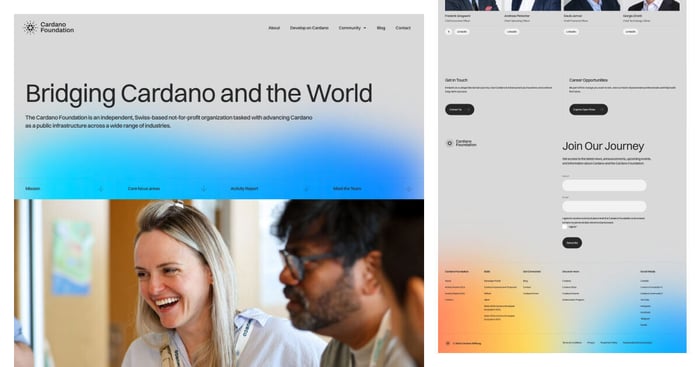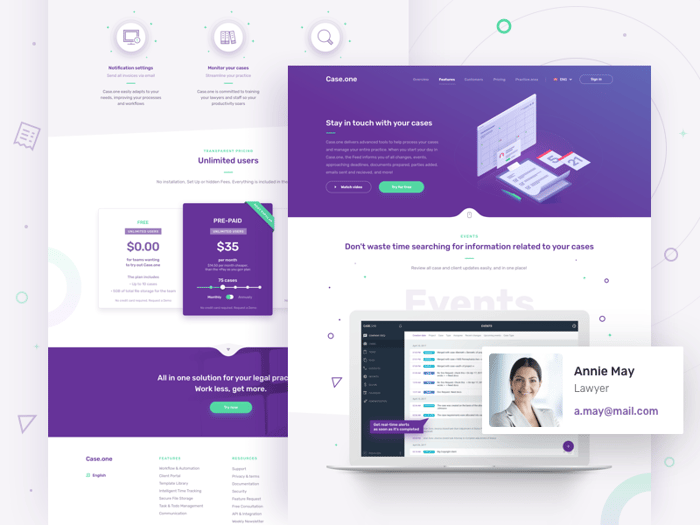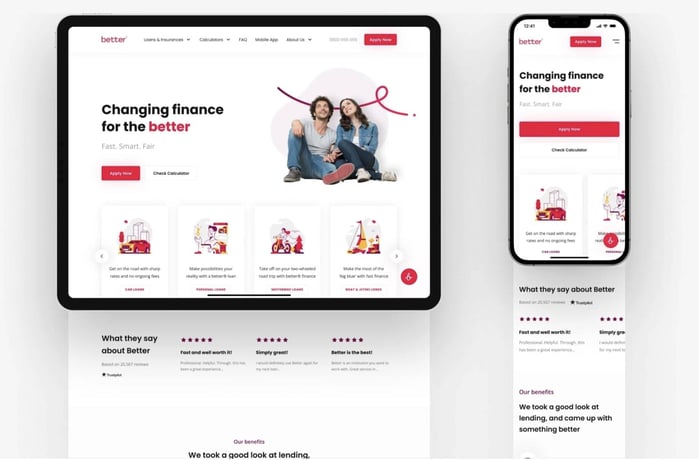When Is It Time to Redesign Your Website? 7 Key Indicators to Watch

In this article, we will explore when is it time to redesign your website by helping you identify these signs and guiding you through the key indicators that suggest it’s time for a redesign.
Key Takeaways
- Look out for high bounce rates and low user engagement. These are clear signs that your website may need a redesign.
- An outdated design or poor mobile responsiveness can turn potential customers away, making a redesign essential for staying competitive.
- Regularly assessing performance metrics and planning for ongoing maintenance are crucial steps after a website redesign to ensure continued success.
What Is a Website Redesign?
A website redesign involves major structural and aesthetic changes to improve functionality and enhance user experience. Unlike a simple refresh, which might only update a few visual aspects, a redesign typically entails substantial updates to the site’s code, content, layout, and visual elements. This process is resource-intensive and requires a clear understanding of both user needs and existing site performance to be successful.
The goal of a web design website redesign strategy is to align the site with business objectives and address target audience needs. This means not only making the site look better but also improving its usability, accessibility, and overall performance.
Key considerations for a successful redesign project include adapting to changing business needs, emphasizing mobile optimization, engaging the appropriate team, and ensuring ongoing site security and flexibility.
Key Signs That Indicate It's Time for a Website Redesign
Recognizing the signs that it’s time to redesign your website can save you from losing valuable visitors and potential sales. High bounce rates, low engagement, and outdated design are just a few indicators that a redesign might be necessary.
High Bounce Rate and Low User Engagement
High bounce rates are often a red flag indicating a poor user experience. When visitors leave your site quickly, it suggests they’re not finding what they’re looking for or the site isn’t engaging enough. Low user engagement metrics, such as short session durations and minimal interactions, highlight that your website may not meet its key performance indicators (KPIs).
Analyzing metrics and user interaction data is vital for identifying the need for a website redesign. Tools like heatmaps can visually show how visitors interact with your site, highlighting areas where engagement drops. Resolving these issues can create a more seamless user experience and increase visitor engagement.

Outdated Design and Functionality
An outdated website design can deter users and negatively impact their perception of your brand. Elements like Flash, auto players, and shiny banners are not only visually unappealing but also signal that your website is behind the times. Customers may perceive a brand as stale if their website is outdated, which can drive them to competitors.
Redesigning a website every 2-3 years helps stay current with trends. If you can’t remember the last redesign of your website, it’s likely time for an update. Incorporating contemporary design elements and studying competitors’ websites can help improve an outdated site’s design and functionality.
Poor Mobile Responsiveness
With the increasing number of mobile users, ensuring your website is mobile-friendly is crucial. Mobile-friendliness is essential for searches on smartphones and tablets; it ensures users remain engaged with the site. Common indicators of poor mobile responsiveness include the site looking sloppy or difficult to navigate on mobile devices.
High abandonment rates among mobile users suggest that a website is not optimized for mobile access. Responsive design enables a website to adapt to different screen sizes, enhancing user experience across devices.
Prioritizing mobile optimization meets user expectations and reduces abandonment rates.
Slow Site Speed
Site speed is a critical factor in retaining visitors and improving search engine rankings. A load time increase from one second to three seconds raises the bounce probability by 32%, significantly impacting user engagement. A third of visitors may leave immediately if a website doesn’t site load quickly, highlighting the importance of fast loading times.
Google PageSpeed Insights can be used to diagnose website loading page speed and identify areas for improvement. Slow-loading sites can result from inefficient coding, high traffic, or large visual elements.
Stripping away elements that slow it down and hosting large video files on third-party sites can help enhance website speed.
Declining Search Engine Rankings
Declining search engine rankings are a clear indicator that your website may need a redesign. Outdated SEO practices can fail to align with current algorithms, reducing your site’s visibility. Tools like HubSpot’s SEO Marketing Software can help diagnose poor SEO performance before a redesign.
A website redesign can optimize pages and improve content marketing strategies to attract more visitors. Utilizing a blog to maintain fresh content is crucial for improving search rankings. A responsive design also impacts search engine rankings and provides a better user experience.
Business Growth and Changing Goals
As businesses evolve, their website must be updated to reflect new goals and offerings. A website redesign helps align the website with evolving business objectives and updated branding. If your product range changes significantly, you should update your website to reflect new products and services.
Failing to ensure that your website reflects the updated brand can lead to losing brand recognition and quality leads. Business growth and changing objectives indicate that it’s time for a website redesign to support new functions and offerings.
Frequent Customer Complaints
Frequent customer complaints about usability suggest it might be time for an overhaul. Customer complaints indicating usability problems highlight significant issues that need to be addressed. Persistent complaints can point directly to the necessity for a website overhaul.
Addressing these usability issues can lead to improved user satisfaction and loyalty. Ensuring a seamless user experience is key to retaining customers and reducing negative feedback.
How To Prepare for a Website Redesign?
Careful planning and research are essential before diving into a website redesign. This preparation helps avoid repeating past mistakes and ensures user satisfaction. Establishing a clear blueprint that addresses identified needs is the primary purpose of planning the redesign.
Assess Current Performance Metrics
Establishing a performance baseline is crucial to understand current website efficiency before redesigning. Tracking user behavior over a minimum of 30 days helps establish a solid performance baseline. Tools like Google Analytics help identify pain points, track user behavior, and inform design decisions.
Performance metrics should include user engagement rates to assess the effectiveness of the redesign. Web analytics can help determine common paths and exit points for visitors on your website. This data is valuable for making informed decisions during the redesign process.
Define Clear Redesign Goals
Establishing specific, measurable goals ensures that the redesign aligns with the intended outcomes for user engagement and conversions. A website redesign can boost lead generation and conversion statistics, making it crucial to set clear objectives.
Alignment among stakeholders is essential in a website redesign to ensure that all perspectives are considered, leading to a successful outcome. Responsive design allows a website to adjust its layout and content based on the device used, enhancing user experience for varying audiences.
Conduct a Thorough Content Audit
Regularly updating the website with fresh content is essential for improving search engine visibility. Fresh and relevant content improves search engine ranking. Constant technical adjustments and content updates are key factors for maintaining visibility on search engines and keeping the site fresh.
A content audit assists in recognizing valuable content that should be preserved or enhanced during the redesign process. Not updating product page information on your website can lead to a negative image and loss of potential clients.
Ensuring that website content is up-to-date and relevant is crucial for user satisfaction and search engine optimization on the current site.
Successful Website Redesigns
Real-world examples of successful website redesign for an existing website offer insights into effective strategies and measurable improvements.
Let’s explore some case studies that demonstrate the benefits of modernizing online platforms.
Cardano Foundation
The Cardano Foundation faced the challenge of enhancing its digital presence and creating a more user-friendly, visually appealing website to better represent its mission and growing influence in the blockchain space. Locofy was used to speed up the development of web components, and Tailwind CSS offered a utility-first approach, helping to quickly apply consistent styling across the site.
The redesign achieved a 24% increase in sessions, a 54% boost in event count, and a 24% rise in events per session. The organic traffic growth of the website redesign proved better accessibility for its users. This example highlights the impact of a well-executed redesign on user engagement and accessibility.

Case.One
Netguru’s Product Design team worked intensively on creating a fully original design for Case.One, which included comprehensive industry research and a modern design concept. Case.One faced fierce competition and a relatively saturated market, necessitating a design that stood out visually from competitors.
The redesign resulted in significant visibility, garnering over 18,000 views on Behance due to its standout design. After the redesign, Case.One continues to grow and has received international attention for its designs.

Better
Better, a New Zealand-based company specializing in insurance offers, personal loans, travel loans, and various vehicle loans, initially requested a simple landing page redesign. However, they transitioned from a basic landing page to a fully developed website, significantly improving user interaction and lead generation capabilities.
The redesign led to increased revenue and lower bounce rates. Better’s promises to clients, such as low fixed interest rates, zero hidden fees, and cost savings on interest, were more effectively communicated through the new website, enhancing user engagement and lead capture.

Polpharma API
Polpharma, the largest Polish pharmaceutical manufacturer, partnered with Netguru to redesign and develop its API website with the goal of optimizing lead generation and creating a modern user experience. The design approach utilized Webflow to create a sleek, minimalistic design tailored to appeal to a technical audience, ensuring a modern aesthetic.
To optimize lead generation, tools like Google Analytics, Google Tag Manager, LinkedIn Insight Tag, and Hotjar were integrated into the redesign to analyze user interaction. A comprehensive usability audit, including mouse heatmaps and scroll maps, was implemented to understand user interactions and improve readability, leading to a perfect Net Promoter Score (NPS) of 10 for the new website.
.jpg?width=700&height=367&name=Polpharma%20CS%20hero%20image%20(1).jpg)
Post-Launch Checklist for Your Redesigned Website
After launching your redesigned website, it’s crucial to monitor and maintain your site’s performance to ensure it meets user expectations, core web vitals, and business goals. Users expect pages to load quickly and efficiently.
This post-launch phase marks the beginning of continuous improvement.
1. Monitor Performance Metrics
Continuously tracking key performance indicators (KPIs) helps measure the success of a website redesign effort. Tools like Google Analytics can document current performance, establish a baseline, and identify areas needing improvement. High bounce rates and low engagement metrics indicate poor user experience, requiring further analysis and potential redesign efforts.
Slow loading times negatively impact user retention and search engine rankings, highlighting the need to regularly assess site speed. Quickly resolving bugs or issues that arise post-launch is essential to maintaining a seamless user experience.
Establishing a maintenance plan ensures your website remains up-to-date and performs optimally, enhancing user satisfaction.
2. Address Bugs and Issues
Identifying and prioritizing high-impact bugs can help improve user experience more effectively. Effective user experience improvement relies on addressing the most critical bugs first. A process for ongoing bug monitoring ensures your website operates optimally over time.
Quickly resolving bugs or issues that arise post-launch is crucial to maintaining a seamless user experience. Promptly addressing these issues prevents minor problems from escalating and ensures the website continues to meet user expectations.
3. Plan for Ongoing Maintenance
Ongoing website maintenance is crucial for ensuring that your site remains relevant and functional in an ever-evolving digital landscape. Regular updates and security checks are vital to maintaining website performance over time. Effective maintenance helps improve load times and user experience, essential for retaining visitors and improving search rankings.
Planning for ongoing maintenance involves scheduling regular check-ups, updating content, and staying informed about the latest web development trends. This proactive approach ensures that your website continues to deliver value to users and supports your business goals.
Summary
A website redesign is a significant undertaking that can greatly impact your business’s online presence and performance. Recognizing the signs that indicate it’s time for a redesign—such as high bounce rates, outdated design, poor mobile responsiveness, slow site speed, declining search engine rankings, business growth, and frequent customer complaints—is crucial for maintaining a competitive edge.
By carefully preparing for a redesign, setting clear goals, and conducting a thorough content audit, you can ensure that your new site aligns with your business objectives and meets user expectations. Real-world case studies, such as those of the Cardano Foundation, Case.One, Better, and Polpharma API, demonstrate the tangible benefits of a well-executed redesign. Finally, monitoring performance, addressing bugs, and planning for ongoing maintenance are essential steps to sustain the success of your redesigned website.



